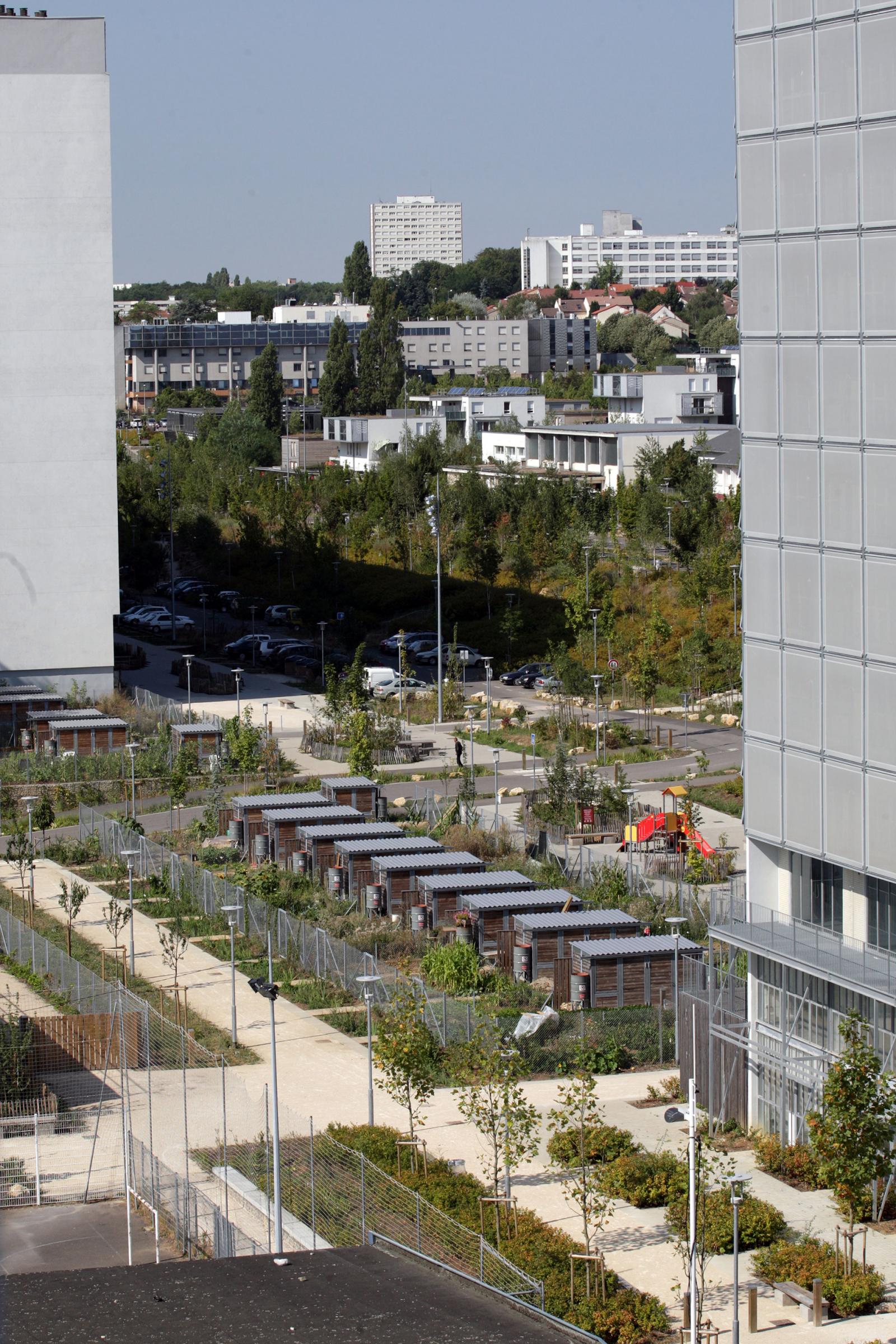"This disctrict of "Plateau de Haye" is part of the EcoQuartier approach, is one of the most ambitious urban renewal projects. In line with the development of the New Urban Renewal Program, work was carried out this year [2012] on the challenges of opening up territory to its urban and forestry environment in order to confirm the "Forest City" approach initiated by the architect-town planner Alexandre Chemetoff" (Ref. 1). It received the EcoQuartier National Grand Prize (Ref. 2). A forest, community gardens and a green corridor are being developed with a rainwater recovery system (Ref. 2). Work is set to continue until 2024 (Ref. 10). "It will first allow work to be done on the functionalities of the district : development of spaces freed up by the demolition of the Blanc Sycamore and the Purple Beech, reconversion of the Tamaris and Ombelles into housing, shops and spaces dedicated to companies, creation of green spaces , shared gardens and parking" (Ref. 10).
Overview
Nature-based solution
- Grey infrastructure featuring greens
- Alley or street trees and other street vegetation
- Institutional green space
- Other
- Parks and urban forests
- Large urban parks or forests
- Pocket parks/neighbourhood green spaces
- Green corridors and green belts
- Community gardens and allotments
- Community gardens
- Green areas for water management
- Swales and filter strips
Key challenges
- Climate action for adaptation, resilience and mitigation (SDG 13)
- Climate change mitigation
- Water management (SDG 6)
- Stormwater and rainfall management and storage
- Green space, habitats and biodiversity (SDG 15)
- Green space creation and/or management
- Environmental quality
- Soil quality improvement
- Air quality improvement
- Noise reduction
- Regeneration, land-use and urban development
- Promote natural styles of landscape design for urban development
- Inclusive and effective governance (SDG 16)
- Inclusive governance
- Health and well-being (SDG 3)
- Enabling opportunities for physical activity
- Creation of opportunities for recreation
- Economic development and employment (SDG 8)
- Real estate development
- Cultural heritage and cultural diversity
- Preservation of natural heritage
- Promotion of cultural diversity
- Sustainable consumption and production (SDG 12)
- Sustainable consumption
Focus
Project objectives
Implementation activities
Climate-focused activities
Climate change mitigation:
- Invest in public transport/bicycle infrastructure as a means to prevent car use
- Raise public awareness of behaviours, lifestyle and cultural changes with mitigation potential
Main beneficiaries
- Local government/Municipality
- Citizens or community groups
- Marginalized groups: Socio-economically disadvantaged populations (e.g. low-income households, unemployed)
Governance
Management set-up
- Co-governance with government and non-government actors
Type of initiating organisation
- Local government/municipality
- Citizens or community group
- District/neighbourhood association
Participatory approaches/ community involvement
- Dissemination of information and education
- Consultation (e.g. workshop, surveys, community meetings, town halls)
- Citizen oversight (e.g. boards, advisory)
- Citizen monitoring and review
- Other
Details on the roles of the organisations involved in the project
Project implemented in response to ...
Financing
Total cost
Source(s) of funding
- Public national budget
- Public regional budget
- Public local authority budget
Type of funding
- Earmarked public budget
- Direct funding (grants, subsidies, or self-financed projects by private entities)
Non-financial contribution
Impacts and Monitoring
Environmental impacts
- Climate change
- Reduced emissions
- Environmental quality
- Improved air quality
- Reduced noise exposure
- Water management and blue areas
- Increased protection against flooding
- Green space and habitat
- Promotion of naturalistic styles of landscape design for urban development
- Increased green space area
- Increased number of species present
Economic impacts
- Increase of green jobs (e.g. paid employment positions)
- Stimulate development in deprived areas
- Generation of income from NBS
- Other
Socio-cultural impacts
- Social justice and cohesion
- Improved social cohesion
- Improved liveability
- Improved access to urban green space
- Increased visibility and opportunity for marginalised groups or indigenous peoples
- Increased opportunities for social interaction
- Increased involvement of locals in the management of green spaces
- Increased access to healthy/affordable food
- Increased sustainability of agriculture practices
- Health and wellbeing
- Improved physical health
- Gain in activities for recreation and exercise
- Cultural heritage and sense of place
- Promotion of cultural diversity
- Protection of natural heritage
- Increased sense of place identity, memory and belonging
- Increased awareness of flora and fauna as culturally and historically meaningful
- Increased appreciation for natural spaces
- Other
Type of reported impacts
Presence of formal monitoring system
Presence of indicators used in reporting
Presence of monitoring/ evaluation reports
Availability of a web-based monitoring tool
References
2. Servir le public (2012). "Nancy : Plateau de Haye, la métamorphose d’un quartier". Available at: Source link (Accessed: August 18, 2020).
3. Sabarly, Colette (2014). "A Nancy, un nouveau quartier pour changer l'image du plateau de Haye". Available at: Source link August 18, 2020).
4. Solorem (n.d). "Le Plateau de Haye, un territoire éco-responsable". Available at: (Website not available in 2020).
5. Solorem (n.d). "Un Grand Projet Plateau de Haye Urbain". Available at: Source link (Accessed: August 18, 2020).
6. Grand Nancy (n.d). "Démocratie participative". Available at: Source link (Accessed: August 18, 2020).
7. Grand Nancy (n.d). "Urbanisme". Available at: Source link (Accessed: August 18, 2020).
8. Grand Nancy (n.d). "LE PLAN LOCAL D'URBANISME INTERCOMMUNAL (PLUi) PRECISERA LA STRATEGIE DU GRAND NANCY POUR LES DIX ANNEES A VENIR". Available at: Source link (Accessed: August 18, 2020).
9. Grand Nancy (2016). "Les Natures en Villes au secours des respirations urbaines". Available at: Source link (Accessed: August 18, 2020).
10. Grand Nancy (n.d.). "L'Ecoquartier Plateau de Haye". Available at: Source link (Accessed: August 18, 2020).


